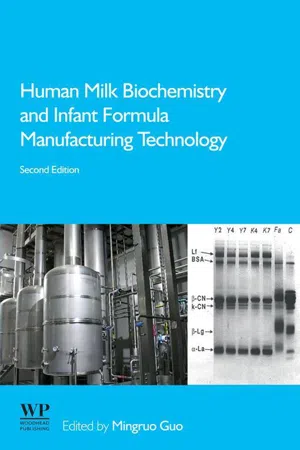
- 422 pages
- English
- ePUB (mobile friendly)
- Available on iOS & Android
Human Milk Biochemistry and Infant Formula Manufacturing Technology
About This Book
Human Milk Biochemistry and Infant Formula Manufacturing Technology, Second Edition covers the history of bottle feeding, its advantages and disadvantages when compared with breast-feeding, human milk biochemistry, trends and new developments in infant formula formulation and manufacturing, and best practices in infant formula processing technology and quality control. The book also covers human milk proteomics as a new, separate chapter and provides additional information on infant formula clinical trial guidelines. In addition, the book includes information about the formulation and processing of premature and low birth weight infant formula.
This book is sure to be a welcome resource for professionals in the food and infant formula industry, academics and graduate students in fields like nutrition, food sciences, or nursing, nutritionists and health professionals, government officials working in relevant departments, and finally, anyone interested in human milk and infant formula.
- Reviews both human milk biochemistry and infant formula processing technology for broad coverage
- Features a comprehensive review on the human milk protein profile using proteomics technology
- Contains information on infant formula processing technology
- Provides guidelines on infant formula clinical trials and related topics
Frequently asked questions
Information
Introduction: Trends and issues in breastfeeding and the use of infant formula
Abstract
Keywords
1.1 Introduction
1.2 Human milk and infant formula
1.2.1 Human milk
1.2.2 Infant formula
1.3 History of infant feeding
1.3.1 Wet nursing
1.3.2 Medical developments: the 19th and 20th centuries
1.3.2.1 Commercial interests
| 1810 | Nicholas Appert developed sterilized food in sealed containers |
| 1835 | William Newton patented evaporated milk |
| 1847 | Grimsdale Patent for evaporated milk |
| 1853 | Gale Borden added sugar to evaporated milk and sold it as Eagle Brand condensed milk |
| 1866 | Nestlé... |
Table of contents
- Cover image
- Title page
- Table of Contents
- Copyright
- List of contributors
- Preface
- Part I: Human milk
- Part II: Infant formula formulation and processing
- Part III: Infant formula quality issues
- Index